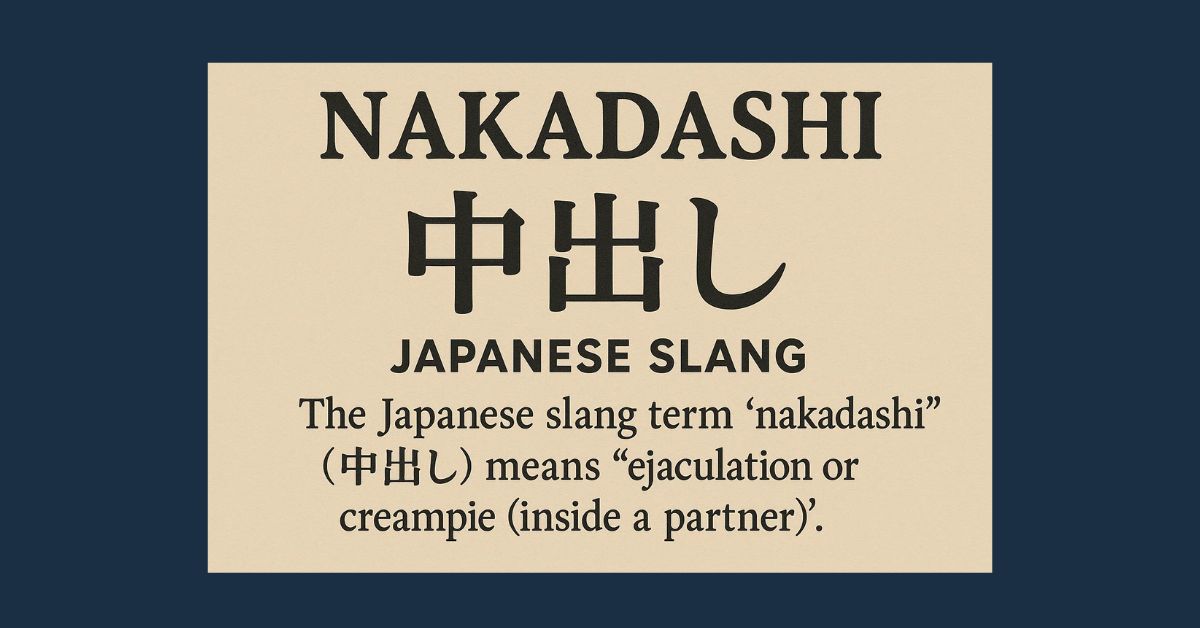If you’ve ever wondered what nakadashi is or heard the term nakadashi meaning in Japanese slang, you’re not alone. Many people learning Japanese or watching anime get curious about this word. Nakadashi is a slang term that has a specific adult meaning, so understanding its proper use and context is important.
In this article, we’ll explore the nakadashi meaning in Japanese and explain the nakadashi def clearly. Knowing these details helps you better understand Japanese media and avoid confusion or awkward situations when you come across this word.
What is Nakadashi? Understanding Its Meaning in Japanese Slang
Nakadashi (中出し) is a Japanese slang word made by combining two simple words: “naka” meaning “inside” and “dashi” meaning “to release.” The nakadashi meaning is specific to adult situations and refers to a private act between partners. This slang is often seen in adult anime, manga, or videos.
Because of its mature nature, the nakadashi meaning in Japanese is not taught in most language classes or textbooks. Still, understanding this term and similar Japanese slang helps learners avoid mistakes when watching uncensored media or chatting online. It’s part of learning real-world Japanese language and culture.
Note: This article discusses adult language for educational purposes. The term analyzed here is mature in nature and understanding its context helps Japanese language learners navigate cultural nuances appropriately.
Etymology and Linguistic Structure
To understand nakadashi, it helps to break down the words that make up the term.
- Naka (中): Means “inside” or “within” in Japanese (Commonly used in daily vocabulary (e.g., naka ni iru – “to be inside”)
- Dashi (出し): Comes from the verb dasu, meaning “to release,” “to put out,” or “to take out” (Appears in many compound words (e.g., demasu – “to go out”)
The nakadashi meaning combines both ideas into a direct slang term that refers to releasing inside. Understanding this breakdown helps language learners recognize how Japanese slang and compound words are formed in real contexts.
Word Formation Pattern
The way nakadashi is formed follows a common word-building style in Japanese.
- It mixes a location word (naka) with an action word (dashi).
- This pattern is often seen in slang and compound expressions.
- It helps give direct and specific meanings in Japanese vocabulary.
Knowing this pattern makes the nakadashi meaning easier to understand and shows how Japanese slang often builds meaning through simple word combinations. It’s a helpful trick for spotting similar terms in media or conversation.
Cultural Context and Usage
To truly get the nakadashi meaning, it’s important to know when and where this slang is typically used.
Media Appearances
The nakadashi meaning often comes up in specific types of Japanese media, especially content meant for adults.
- Nakadashi is frequently seen in adult anime or uncensored manga.
- It appears in certain genres of Japanese videos and doujinshi.
- You may find it mentioned in online forums discussing slang or adult content.
- Some slang dictionaries also include nakadashi for language learners or translators.
Knowing where nakadashi shows up helps avoid confusion when watching or reading Japanese content.
Social Context
Understanding the nakadashi meaning also means knowing how people feel about it in Japanese society.
- It’s considered explicit and not used in polite conversations.
- Native speakers avoid saying nakadashi in formal or public settings.
- It’s mostly used in private, adult, or media-related contexts.
- Using it casually may come across as rude or inappropriate.
In Japanese culture, slang like nakadashi carries social weight. Even if you understand the word, it’s important to know when not to use it. Respecting context helps you sound natural and culturally aware.
Similar Expressions in Japanese Slang
Just like nakadashi, Japanese has other slang words used to talk about intimacy or adult themes. These words often appear in anime, manga, or casual conversations.
- Aibu (愛撫) means gentle touching or physical affection.
- Ecchi (エッチ) is a playful word for sexual things, often used in anime.
- Sukebe (すけべ) describes someone who is very pervy or has strong desires.
These terms, like nakadashi, are part of informal or adult language. Learning these alongside the nakadashi meaning helps you understand how Japanese expresses different levels of intimacy in slang. These phrases often show up in the media and give more insight into cultural expression.
Want to explore Japan’s culture?
Explore Japan’s amazing culture, unique traditions, and secret spots with our easy-to-follow guides. Enjoy free tips on food, travel, and history straight from the insiders!
Common Misunderstandings
Many people learning Japanese mix up or misuse slang like nakadashi because they don’t fully understand its meaning or context. Knowing the real nakadashi meaning can help avoid awkward or embarrassing moments.
- Learners often translate nakadashi directly without understanding the slang.
- Some think it’s a normal word used in daily conversation.
- Media exposure without explanation leads to confusion.
- It’s rarely covered in Japanese language classes or apps.
Understanding the truth behind Japanese slang terms like nakadashi is key to respectful and smart language use. With the right knowledge, you can avoid miscommunication and learn the language more naturally.
Language Learning Perspective
Looking at slang like nakadashi from a language learning point of view helps us understand how real Japanese is spoken. The nakadashi meaning also shows how words are built and used in different situations.
- It teaches how compound words like nakadashi are formed.
- Shows the link between kanji meanings and slang use.
- Helps learners understand what’s appropriate in different settings.
- Builds awareness of Japanese culture and communication styles.
Learning Japanese isn’t just about polite phrases, it’s also about knowing what to say, when, and how. Words like nakadashi highlight the importance of context in mastering the language.
When You Might Encounter This Term
There are certain times and places where you might come across the word nakadashi, especially if you’re into Japanese media or online communities.
- While watching adult anime or uncensored manga.
- In online forums or fan chats discussing slang or mature topics.
- When reading raw Japanese content that hasn’t been translated.
- During casual talk with native speakers who assume you know slang.
Knowing the nakadashi meaning helps you avoid confusion and respond properly when the term shows up. It’s all about understanding real language beyond the classroom.
Tips for Navigating Japanese Slang
When learning slang like nakadashi, it’s important to be careful and thoughtful about how you understand and use the term.
- Context is key: Always look at where and how nakadashi is used before trying to understand or say it.
- Consult multiple sources: Use books, websites, and real conversations to check the nakadashi meaning.
- Ask appropriate sources: If unsure, ask a trusted native speaker or teacher not random internet posts.
- Remember cultural differences: Japanese people may view slang like nakadashi differently than your own culture does.
Understanding slang takes more than translation; it needs cultural knowledge too. Learning the nakadashi meaning helps you stay respectful, accurate, and confident as you grow in the language.
Related Post: Oi Oi Oi Meaning: What It Really Means in Japanese
Appropriate Alternatives in Conversation
If you’re talking about adult topics in a respectful or formal setting, it’s better to use softer words instead of slang like nakadashi. Knowing alternatives helps you talk clearly without sounding rude or inappropriate.
- Use medical or formal terms when discussing intimacy in serious or educational contexts.
- Choose polite euphemisms instead of direct slang like nakadashi.
- Speak indirectly most native speakers understand without needing explicit words.
Learning the nakadashi meaning is useful, but using it wisely shows maturity and cultural awareness. Picking the right words helps you sound respectful and natural in Japanese conversations.
Q&A: Common Questions About Nakadashi Meaning Slang
Is nakadashi a common term in everyday Japanese conversation?
No, nakadashi is not used in daily conversation. It’s slang and only appears in adult or specific media contexts.
Will I need to know this term for Japanese language proficiency tests?
No, nakadashi won’t appear on tests like the JLPT. It’s slang, not part of standard exam vocabulary or grammar.
Are there regional differences in how this slang is used?
The nakadashi meaning is generally the same across Japan, but how often it’s used may vary between cities and regions.
How should I react if I hear this term in Japan?
Stay calm, recognize it as adult slang, and avoid repeating it. Nakadashi isn’t appropriate for casual or polite situations.
What does nakadashi mean in Japanese slang?
In slang, nakadashi means ejaculating inside a partner. It’s an explicit term mostly used in adult Japanese media or forums.
What is Nakadashi in Japanese slang?
Nakadashi in Japanese slang refers to a sexual act. It’s made of “naka” (inside) and “dashi” (to release).
What is a rude word for you in Japanese?
Words like “kisama” or “temee” can be rude ways to say “you” in Japanese, especially in arguments or anime.
Conclusion
Learning the nakadashi meaning is just one part of becoming truly fluent in Japanese. While slang like nakadashi isn’t taught in regular classes, understanding it can help you avoid confusion and awkward moments. Just like knowing when to use “sayonara” or how to express strength in Japanese, mastering both formal and informal language is key.
If you’re serious about learning, resources like the JLPT N5 Study Guide can help build a solid foundation while keeping cultural respect in mind. Great language learners don’t just know words they also know when and how to use them the right way.

